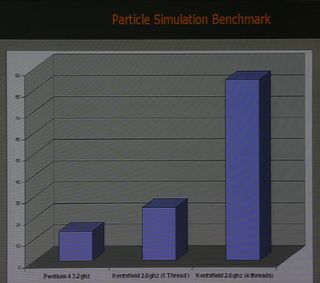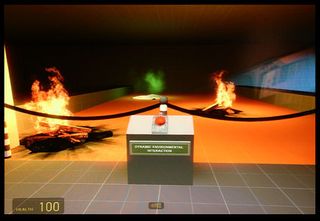Intel's quad-core rings in a new era of enthusiast systems
Benchmark results provided by Valve
Kentsfield offers 8x the particle performance of the Pentium 4
Valve did not provide a lot of details about possible performance gains with quad-cores in physics. However, the firm said that four Kentsfield cores provide roughly 3.4 times the particle performance of one Kentsfield core, which would indicate a nice scaling capability of Valve's improved game engine. The power of a quad-core chip is even more impressive when compared to a Pentium 4 3.2 GHz processor: The game developer said that a quad-core Kentsfield has roughly eight times the particle simulation horsepower of the aging single-core chip.

Artificial intelligence, short AI, is the other main area targeted by multi-core processors. The company showed off simple "experiments", which demonstrated that a quad-core chip is powerful enough to simulate the behavior of up to 500 independent critters - which were able to go after enemies as a group, which could move while avoiding dangerous objects such as fire pits. The demo critters could also be motivated to arrange in a certain order, which showed that a substantial number of independent objects could be controlled in a very precise way.
Even the simple graphics of those demos provided a clear hint of how powerful quad-core processors will be. Five years ago, game developers complained about smallish processing horsepower that allowed them to simulate the behavior of only one intelligent object per screen. Valve has reached 500 simple critters already and engineers mentioned that it can do the same with about 200 soldiers in another demo. In the end, this could mean that objects will be acting just as realistic as they look today.

Some physics effects run by Valve. The fire pits also served as obstacles that were avoided by demo critters
All these benefits require a completely new way to program games. For Valve, it means that the company has to invest into a transition which engineers called "significant" and Valve founder Gabe Newell, who briefly stopped by for the briefing, "painful." Leaving a time of creating single-threaded code that depends on the chronological events in a series of events behind, the company has found a strategy to utilize quad-cores as much as possible - which means that a game will try to exhaust all four cores at any given time.
The company refers to its development strategy as "hybrid threading," which uses a combination of coarse threading and fine grain threading. Coarse threading is relatively simple to create and will put entire tasks, such as rendering or AI, onto different cores. Coarse threading apparently does not scale very well, resulting in a speed gain of about 1.2x, according to Valve. Fine grain threading, on the other side, will divide tasks across multiple cores and complement coarse threading to approach a 100% utilization of each core. Valve's engineers mentioned that this approach scales extremely well and should result in some "exciting" results. For pure development purposes, the company said that quad-core will save "thousands" of hours in calculation time - but conceded that programming multi-threaded applications will get much more complicated.

Controlling 500 individual intelligent objects: In this case, the demo critters are motivated to move into a specific position
Stay on the Cutting Edge
Join the experts who read Tom's Hardware for the inside track on enthusiast PC tech news — and have for over 25 years. We'll send breaking news and in-depth reviews of CPUs, GPUs, AI, maker hardware and more straight to your inbox.
All those benefits appear to specifically address quad-cores - and you may have noticed that I mentioned a little earlier that quad-core is the way to go, not two dual-cores. While it may be a bit pre-mature to judge how well two dual-core Xeons will perform against Kentsfield and how well AMD's 4x4 platform (which will rely on two dual-cores as well) will compete with Kentsfield, Valve provided some indications that a quad-core chip will deliver the benefit the company is intending to provide. Tom Leonhard, one of the lead developers in Valve's multi-core team, said that the performance differences between two dual-cores and one quad-core could be significant in certain scenarios. He stressed that Valve is trying to avoid such scenarios, but could not confirm that this could be achieved across the board.
Pressed to provide a better idea which will be the better performing gaming platform, Valve declined to make any recommendations. Instead, company officials noted that benchmarks results of hardware sites should offer enough detail for enthusiasts to find the best choice. However, Gabe Newell stated that Valve has delayed the purchase of new computers until now - and will replace its development machines with quad-cores (read: not 2P dual-core systems) immediately.
At least for now it is clear that enthusiasts who consider their PC as an investment to a certain degree should not buy a dual-core system anymore. If you are throwing $4000 or more into a serious gaming computer this Christmas, then Intel's Kentsfield (officially called Core 2 Extreme QX6700) may be your only choice. Valve declined to discuss AMD's 4x4, which - in combination with the firm's confirmation that it will transition its development systems to quad-core - leaves a question mark behind the capability of the platform: It is yet another indication that AMD may need a quad-core processor rather sooner than later.
Related articles:
Intel Quad-Core benchmarks to flood the net
Intel roadmap confirms 2.67 GHz quad-core Core 2 Extreme
AMD to take on Intel with accelerated roadmap, native quad-core
Intel quad-core processors may see spike in power - sources
Gigabyte introduces "quad-core ready" motherboard
Intel shows off first x86 quad-core processor
Intel roadmap update - prototypes of first quad-core desktop processor built
Intel is back: Core 2 Duo launches
Tom's Hardware: Core 2 Duo smokes AMD's Athlon 64 X2

Most Popular

